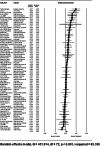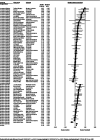Hot spots policing of small geographic areas effects on crime
- PMID: 37133274
- PMCID: PMC8356500
- DOI: 10.1002/cl2.1046
Hot spots policing of small geographic areas effects on crime
Abstract
Background: In recent years, crime scholars and practitioners have pointed to the potential benefits of focusing crime prevention efforts on crime places. A number of studies suggest that there is significant clustering of crime in small places, or "hot spots," that generate half of all criminal events. Researchers have argued that many crime problems can be reduced more efficiently if police officers focused their attention to these deviant places. The appeal of focusing limited resources on a small number of high-activity crime places is straightforward. If crime can be prevented at these hot spots, then citywide crime totals could be reduced.
Objectives: To assess the effects of focused police crime prevention interventions at crime hot spots. The review also examined whether focused police actions at specific locations result in crime displacement (i.e., crime moving around the corner) or diffusion (i.e., crime reduction in surrounding areas) of crime control benefits.
Search methods: A keyword search was performed on 15 abstract databases. Bibliographies of past narrative and empirical reviews of literature that examined the effectiveness of police crime control programs were reviewed and forward searches for works that cited seminal hot spots policing studies were performed. Bibliographies of past completed Campbell systematic reviews of police crime prevention efforts were reviewed and hand searches of leading journals in the field were completed. Experts in the field were consulted and relevant citations were obtained.
Selection criteria: To be eligible for this review, interventions used to control crime hot spots were limited to police-led prevention efforts. Suitable police-led crime prevention efforts included traditional tactics such as directed patrol and heightened levels of traffic enforcement as well as alternative strategies such as aggressive disorder enforcement and problem-oriented policing. Studies that used randomized controlled experimental or quasiexperimental designs were selected. The units of analysis were limited to crime hot spots or high-activity crime "places" rather than larger areas such as neighborhoods. The control group in each study received routine levels of traditional police crime prevention tactics.
Data collection and analysis: Sixty-five studies containing 78 tests of hot spots policing interventions were identified and full narratives of these studies were reported. Twenty-seven of the selected studies used randomized experimental designs and 38 used quasiexperimental designs. A formal meta-analysis was conducted to determine the crime prevention effects in the eligible studies. Random effects models were used to calculate mean effect sizes.
Results: Sixty-two of 78 tests of hot spots policing interventions reported noteworthy crime and disorder reductions. The meta-analysis of key reported outcome measures revealed a small statistically significant mean effect size favoring the effects of hot spots policing in reducing crime outcomes at treatment places relative to control places. The effect was smaller for randomized designs but still statistically significant and positive. When displacement and diffusion effects were measured, a diffusion of crime prevention benefits was associated with hot spots policing.
Authors' conclusions: The extant evaluation research suggests that hot spots policing is an effective crime prevention strategy. The research also suggests that focusing police efforts on high-activity crime places does not inevitably lead to crime displacement; rather, crime control benefits may diffuse into the areas immediately surrounding the targeted locations.
© 2019 The Authors. Campbell Systematic Reviews published by John Wiley & Sons Ltd on behalf of The Campbell Collaboration.
Figures










Update of
- Protocol
- Systematic Review 2007
- Updated Systematic Review 2012
References
References to included studies
-
- Ariel, B. , & Partridge, H. (2017). Predictable policing: Measuring the crime control benefits of hotspots policing at bus stops. Journal of Quantitative Criminology, 33(4), 809–833.
-
- Ariel, B. , Weinborn, C. , & Sherman, L. W. (2016). “Soft” policing at hot spots—do police community support officers work? A randomized controlled trial. Journal of Experimental Criminology, 12(3), 277–317.
-
- Attermann, C. V. (2017). Investigating hot spots policing. Copenhagen, Denmark: Ministry of Justice Research Office.
-
- Banerjee, A.V. , Duflo, E. , Keniston, D. , & Singh, N. (2014). The efficient deployment of police resources: Theory and new evidence from a randomized drunk driving crackdown in India. Unpublished manuscript.
-
- Beck, J. W. (2010). The effects of directed patrols in unincorporated areas: A case study of the data‐driven approach to crime and traffic safety. Reno, NV: University of Nevada.
References to excluded studies
-
- Alderden, M. A. , Schuck, A. M. , Stephens, C. D. , Lavery, T. A. , Johnston, R. M. , & Rosenbaum, D. P. (2011). Gang hot spots policing in Chicago: An evaluation of the deployment operations center process. Chicago, IL: University of Illinois‐Chicago.
-
- Andresen, M. A. (2015). Identifying changes in spatial patterns from police interventions: The importance of multiple methods of analysis. Police Practice and Research, 16(2), 148–160.
-
- Andresen, M. A. , & Lau, K. C. Y. (2014). An evaluation of police foot patrol in Lower Lonsdale, British Columbia. Police Practice and Research, 15(6), 476–489.
-
- Andresen, M. A. , & Malleson, N. (2014). Police foot patrol and crime displacement: A local analysis. Journal of Contemporary Criminal Justice, 30(2), 186–199.
-
- Barthe, E. P. , & Stitt, B. G. (2011). Impact of increased police presence in a non‐criminogenic area. Police Practice and Research, 12(5), 383–396.
Additional references
-
- Apel, R. , & Nagin, D. S. (2011). General deterrence: A review of recent evidence. In Wilson J. Q., & Petersilia J. (Eds.), Crime and Public Policy (pp. 411–436). New York, NY: Oxford University Press.
-
- Barr, R. , & Pease, K. (1990). Crime placement, displacement, and deflection. In Tonry M., & Morris N. (Eds.), Crime and justice: A review of research (12, pp. 277–318). Chicago, IL: University of Chicago Press.
-
- Berk, R. , Smyth, G. , & Sherman, L. (1988). When random assignment fails: Some lessons from the Minneapolis spouse abuse experiment. Journal of Quantitative Criminology, 4(3), 209–223.
-
- Bittner, E. (1970). The functions of the police in modern society. New York, NY: Aronson.
-
- Bowers, K. , Johnson, S. , Guerette, R. , Summers, L. , & Poynton, S. (2011). Spatial displacement and diffusion of benefits among geographically focused policing initiatives. Campbell Systematic Reviews, 7(1), 1–144.
LinkOut - more resources
Full Text Sources
Miscellaneous
